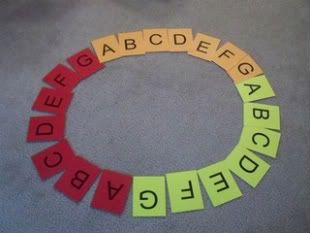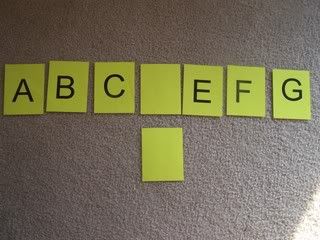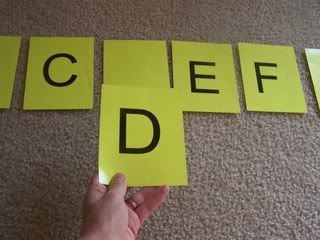
Ender has been learning about the musical alphabet for the past week. I made 8 sets of musical alphabet cards (A-G) about 2 years ago to supplement a few of my music students and the cards have become one of my most used games since they are so versatile and open ended.
I made the font big enough on the cards so that there were 4 letters on one page, and 3 letters and a blank space on the second page. I printed each set on a different color of cardstock (to help young children see each group of A-G as it's own set) and laminated all the cards including the blank cards. I specifically chose to use the uppercase letters for these cards as a prequel to later music theory when we write major keys and chords using uppercase letters and minor keys and chords using lowercase letters.
I'll be listing the games in sequence over the next few weeks as Ender learns the steps. The work should be used in this order and repeated until mastery is shown before moving to the next extension. The first few periods are easy and will be mastered after 2 or 3 times, but later steps can take up to several weeks for mastery. These games are intended for students who already know letters A-G (meaning they can identify them on sight and out of order) and have a fair understanding of what before and after mean. Many 3-year-olds are ready for this kind of work, but some are not. None of these activities are part of any Montessori album I've seen, but we include the cards on Ender's Montessori shelves as a choice during his work period.
Part One
First, we work on identifying the letters. I lay out one set of alphabet cards in a row, in alphabetical order. I ask Ender to say them with me, starting on A. If your child hesitates anywhere, repeat the process as many times as it takes for them to know the letters in order with confidence.
After going through the letter names I hand Ender his own set of alphabet cards (different color) and ask him to line his cards up with mine- A under A, B under B, etc. After he has completed this portion I ask the question, "Do you know what happens after we get to G in the musical alphabet?" And his now-programmed response is, "we start all over again!" So we start with my letter A and say the musical alphabet through to G, then immediately start with his letter A and say the musical alphabet through to G again.

For the next step, I pick up both sets of alphabet cards and put one aside. I ask him to close his eyes and I mix the remaining set so that the letters are out of order. I lay them out in a row as if they are in order. When I ask him to open his eyes I ask him if he sees that cards are out of order. Ender says yes and I ask him to put them back in order from me, starting with A on the left. If he gets stuck anywhere, let's say on finding the letter that comes after D, I will say, "A, B, C, D . . . what comes next?" to help him see that a problem solving strategy here would be to use the letters he already has in order to help him solve the problem. When he has successfully put them back in order, we cheer and say the letters in order aloud again, starting with A.

For the last step in this period, I lay the cards out in alphabetical order and again ask him to close his eyes. I remove one letter card, replace it with the blank card and turn that letter card face down. I ask Ender to open his eyes and I tell him, "one of the letters is missing. Do you see where the empty card is?" I ask him to tell me which letter is missing. If this is difficult I will again use the problem solving strategy of saying "A, B, C . . ." and tapering off just before the missing letter so that he realizes that the letters surrounding the blank card give him a clue as to what might be missing. If he answers incorrectly, I'll say, "hmmm... I think I see that letter over here, so it can't be that one . . ." and pretend that I'm thinking really hard about this problem too.

Once he comes up with the correct answer I show him the letter card that is turned face down, and SURPRISE! He's correct!






No comments:
Post a Comment
Please add your thoughts to the conversation!